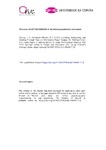Mostrar el registro sencillo del ítem
Codifying, Envisioning, and Ideating Through Data on Information Based Designs
| dc.contributor.author | Marcos, Carlos | |
| dc.contributor.author | Fernández-Álvarez, Ángel J. | |
| dc.date.accessioned | 2024-01-09T19:25:16Z | |
| dc.date.issued | 2022-04-30 | |
| dc.identifier.citation | Marcos, C. L., Fernández-Álvarez, Á. J. (2022). Codifying, Envisioning, and Ideating Through Data on Information Based Designs. In: Ródenas-López, M.A., Calvo-López, J., Salcedo-Galera, M. (eds) Architectural Graphics. EGA 2022 (Vol. 3, pp. 223-232). Springer Series in Design and Innovation, Vol. 23. Springer, Cham. https://doi.org/10.1007/978-3-031-04640-7_23 | es_ES |
| dc.identifier.isbn | 978-3-031-04640-7 (e-book) | |
| dc.identifier.issn | 2661-8192 | |
| dc.identifier.uri | http://hdl.handle.net/2183/34781 | |
| dc.description | This version of the chapter has been accepted for publication, after peer review and is subject to Springer Nature’s AM terms of use, but is not the Version of Record and does not reflect post-acceptance improvements, or any corrections. The Version of Record is available online at: https://doi.org/10.1007/978-3-031-04640-7_23 | es_ES |
| dc.description | Versión final aceptada de: https://doi.org/10.1007/978-3-031-04640-7_23 | es_ES |
| dc.description.abstract | [Abstract]: One of the fundamental issues raised by Mario Carpo in The Second Digital Turn in relation to the digital revolution in architecture has to do with the paradigm shift that incorporates computational logics and replaces conventional “ways of doing” with new “ways of thinking”. The role that information plays in this context allows for new ideation strategies that often invite architects and designers to incorporate data not as something to be analysed and from which to act and make decisions, but directly as project material, thus enhancing information based designs. Some examples are examined in which, in various ways, data is manipulated, abstracted and digitally processed to help formalise the design proposal. Sometimes following form-finding strategies, sometimes deploying geometries encoded in scripts in order to define the form to recall relevant data from an event or to display the information and explore ways of visualising that data to produce the final configuration. Many of these proposals challenge the limits of temporality traditionally associated with architecture and contribute to define a new phenomenology between users and architecture. | es_ES |
| dc.language.iso | eng | es_ES |
| dc.publisher | Springer Nature Switzerland | es_ES |
| dc.relation.uri | https://doi.org/10.1007/978-3-031-04640-7_23 | es_ES |
| dc.rights | © 2022 The Author(s), under exclusive license to Springer Nature Switzerland AG | es_ES |
| dc.subject | Second Digital Turn | es_ES |
| dc.subject | Computational Design | es_ES |
| dc.subject | Envisioning Data | es_ES |
| dc.title | Codifying, Envisioning, and Ideating Through Data on Information Based Designs | es_ES |
| dc.type | info:eu-repo/semantics/bookPart | es_ES |
| dc.rights.access | info:eu-repo/semantics/embargoedAccess | es_ES |
| dc.date.embargoEndDate | 2024-05-01 | es_ES |
| dc.date.embargoLift | 2024-05-01 | |
| UDC.startPage | 223 | es_ES |
| UDC.endPage | 232 | es_ES |
| dc.identifier.doi | https://doi.org/10.1007/978-3-031-04640-7_23 |






